An amazing find — a little known Indian Scout Cemetery
Old Scouts
There’s no other place on earth like this place. There is only one Old Scouts Society and west of Garrison, this is the military graveyard where the Society honors their war dead.
For more than 100 years, North Dakota’s Old Scout Society continues to keep alive the memory of the tribal members who served in the U.S. Army since the time of General Custer.
Here lay members of the Three Affiliated Tribes, the Mandan, Hidatsa, and Arikara who proudly served in the U.S. military. That’s because their skills and abilities were part of U.S. combat in both world wars, the Vietnam war and modern-day conflicts in the Mideast.

Relatives leave memorials at the site of their ancestors who served in the U.S. Military
.
200 Years
The tradition of scouts from the Mandan, Hidatsa, and Arikara people goes back nearly 200 years. Today, the Society is a group of relatives of those historic soldiers. The group honors the U.S. Army veterans of the Indian Wars and other tribal members who served in all branches after the Indian Wars.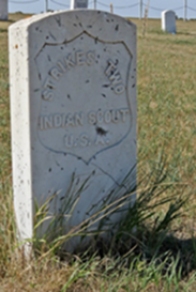
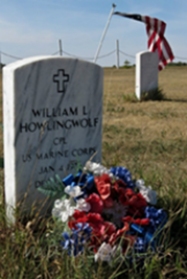
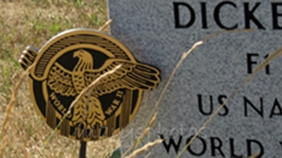
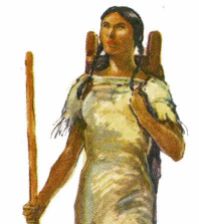
Go back to the first Hidatsa scout who served the United States: Sakakawea (Hidatsa pronunciation suh-KAG-a-wee-uh).
She and her husband Charbonneau helped the Corps of Discovery find its way west and back again.
Protecting the Railroad
Later when the U.S. Army occupied this region to protect the railroad expansion to the west coast, Army commanders relied on scouts from these tribes to provide intelligence about the tribe’s hostile enemies, the warriors of the Sioux Nation. The Mandan, Hidatsa and Arikara scouts carried dispatches, found food and water, tracked game and served as interpreters.
Custer
Several unrelated events converged to create the birth of the long-standing tradition of tribal members joining the U.S. military.
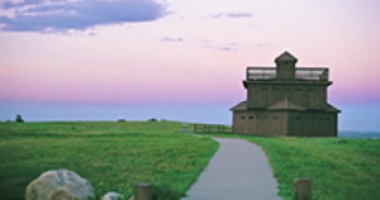
A rebuilt blockhouse above Fort Lincoln marks the uppermost reach of the Fort where General Custer and his scouts once lived.
For example, in 1873, Colonel George Armstrong Custer and the Seventh Cavalry were stationed at Fort Lincoln, south of Mandan, North Dakota. The Seventh Cavalry was to protect the Northern Pacific Railroad Survey crews who had been attacked by hostile Sioux.
Before Custer, hostile Sioux were at war with neighboring tribes, including the Mandan, Hidatsa, and Arikara who had withstood the Sioux attacks, at first.
Smallpox
Then, smallpox wiped out nearly all the three tribes. The deadly scourge had impacted populations from the Royal Palace in England to the families of U.S. Founding Fathers.
Even then, smallpox had not come to the isolated tribes until late. When it did, the people of the upper Missouri, had no immunity and no vaccines. So, thousands of men, women, and children died. That’s why the Mandan tribe joined forces with the Hidatsa and Arikara people who had also been nearly wiped out.
They banded together to defend themselves against a ferocious tribe of the Sioux nation. However, forming a confederacy between the three tribes was insufficient.
A new confederacy
Since they were not strong enough to battle the Sioux, they aligned themselves with the new and stronger enemy of the Sioux – the Blue Coats or the Seventh Cavalry – “the enemy of my enemy is my friend.”
At first, the men of the Arikara or Ree were the first to supply scouts for Custer. Even the Pawnee, distant relations to the Arikara became scouts in the southern plains. rom From 1872 until the late 1800s Arikara scouts were the backbone of the Army’s scouts.
Early Scouts
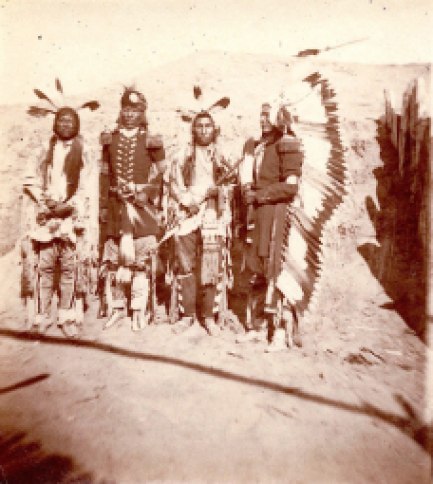
Second from the left, Bobtailed Bull, one of Custer’s favorite scouts in the Indian Wars against the Sioux.
One of the earliest scouts was Red Bear who later was joined by his younger brother Boy Chief. He was one of the first scouts to die in a skirmish with the Sioux while stationed at Fort Lincoln along the Missouri River south of present-day Mandan.
Boy Chief tells the story of his enlistment like this:
“Bobtail Bull brought me to Fort Abraham Lincoln in 1872. Bobtail Bull took me to headquarters to ‘touch the pen’ to my enlistment papers. I thought the medical examination would throw me out, as I was very young. But I passed. In another building, an officer gave me a gun, clothing and two gray blankets.”
Bobtail Bull
A warrior named Bobtail Bull was one of the first Indian scouts to be promoted and receive a commission under Lt. Col Custer who often bragged of this Arikara scout when in Washington. Custer said of Sergeant Bobtail Bull that he was a man of good heart and good character. He promised that if anything happened to Bobtail Bull and his fellow scouts that “their reward will not be forgotten by the government.”
It is said that a good scout who was promoted as Bobtailed Bull was promoted, could earn more than the $13/month paid most soldiers and in some cases earned as much as $50/month
Sgt. Bobtail Bull was one of the first under Custer to fall at Little Big Horn. That was despite the fact that Custer would not use his scouts as a fighting force except for skirmishes. Bobtail Bull, however, boasted of his experience in fighting the Sioux and stood ready for whatever battle commands Custer ordered.
Custer used the scouts to find the enemy, report their movement and act as couriers. On the day of the Battle of Little Big Horn, Custer ordered Bobtail Bull and other scouts to “take the horses away from the Sioux camp. Take away as many horses as possible.” Custer knew that a warrior on foot was no match for a soldier on a horse.
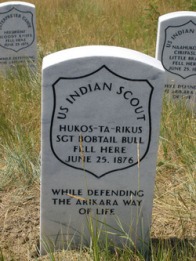
Bobtail Bull’s gravesite is at Little Big Horn, one of the few Hidatsa Scouts in a marked grave off the Fort Berthold Indian Reservation
.
Sgt. Bobtail Bull died defending Arikara way of life
Bobtail Bull got separated from the rest of the troops. Sioux warriors grouped behind him, separating him from help and from escape. A dense swarm of Sioux rode against him and he attempted to fall back. He was left as a solitary horseman, surrounded by circling warriors. Then, he was shot off his horse and so became one of the first to fall at the Battle of Little Big Horn.
Bobtail Bull, Red Bear, Boy Chief, and other scouts served in the U.S. Army from 1866 to 1914 at most western forts. These scouts were model soldiers. So when the U.S. Government mistreated them, their local commanders would speak up for them because they knew they were priceless soldiers. Sadly, the government wouldn’t listen to their own commanders.
The scouts served with fidelity, placing their unique skills at the disposal of the frontier army. To the shame of the U.S. Government, many of these brave soldiers were harshly treated after they served the U.S. Army. For some, prison, poor health, disabilities or even death was the future they faced after serving the United States. Many have been completely forgotten.
(A contemporary of Custer who worked with tribal members of the Mandan, Hidatsa, and Arikara left an influence on the people who remains today. To learn of Harold Case’ missionary work see this link: http://wp.me/pOdPo-HP )
Old Scouts Society
In 1979 the Old Scouts Society of White Shield was established. The group cares for and maintains Post #1 Cemetery at White Shield where several of the scouts of the Seventh Cavalry are buried alongside veterans of WWI, WWII, Korea, and Vietnam.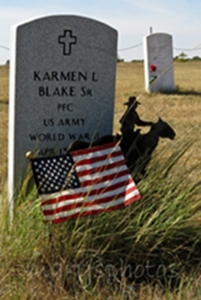
In 1983, the Fort McKeen Detachment, Old Scouts Society was officially formed. Organizers included the grandsons of Bears Belly who was one of the original scouts who served under Custer at Fort Lincoln.
The Fort McKeen Detachment is dedicated to correcting misconceptions about the scouts who served in the U.S. Army. Members educate the public about military scouts and work to keep alive the stories of how the historic scouts influenced American and North Dakota history. They work to preserve and honor the gravesites of the scouts buried at Fort Abraham Lincoln south of Mandan. They also help maintain the cemetery west of Garrison, North Dakota on Highway 1804.
You can honor them, too
As often as possible, I go past the cemetery, often on a motorcycle. I stop to tend to fallen flags and other markers left to honor this group of war dead who contributed much but received so little recognition for their sacrifice. 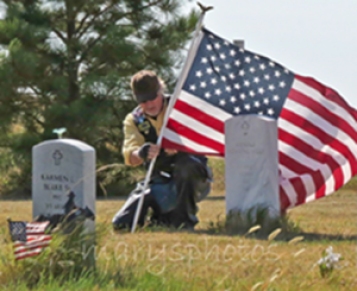 Have you taken the scenic drive past Garrison, up to Parshall on 1804?
Have you taken the scenic drive past Garrison, up to Parshall on 1804?
Did you see the Cemetery?
(This article is excerpted from a script I wrote for a documentary on the Old Scouts Society — yet unproduced. It is the product of months of research at the Fort Berthold Library, the Three Affiliated Tribes Museum and the North Dakota State Historical Society. For more information see
For More:
For more information, read the book Wolves for the Blue Soldiers, Indian Scouts and the auxiliaries with the United State Army 1860-90.
It’s a comprehensive looking at all the times and places and all the tribes who supplied scouts to the U.S. Army, often entering the fight of Indian vs. Indian. The book explains why.






